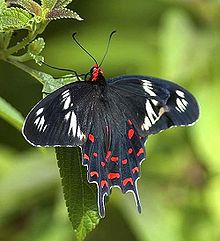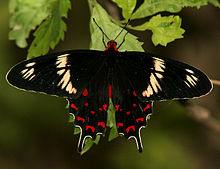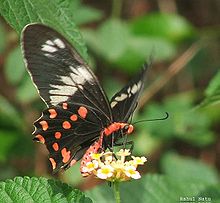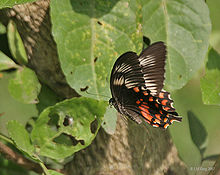- Atrophaneura hector
-
Crimson Rose 
Male in typical basking pose Scientific classification Kingdom: Animalia Phylum: Arthropoda Class: Insecta Order: Lepidoptera Family: Papilionidae Genus: Atrophaneura Subgenus: (Pachliopta) Species: A. (P.) hector Binomial name Atrophaneura (Pachliopta) hector
(Linnaeus, 1758)Synonyms Pachliopta hector
 Male in Hyderabad, India
Male in Hyderabad, India
Crimson Rose (Atrophaneura hector) is a large swallowtail butterfly belonging to the subgenus Pachliopta (Roses) of the Red-bodied Swallowtails (genus Atrophaneura).
Contents
Range
It is found in India and Sri Lanka and possibly the coast of western Myanmar.
In India, it is found in the Western Ghats, southern India (Kerala), eastern India (West Bengal and Orissa), and the Andaman Islands. Also recorded from Pune.
Status
Generally common and not known to be threatened. It is common all along the Western Ghats up to Maharashtra but rare in Gujarat. It is considered to be very rare in the Amphrodog. Protected by law in India.
Description
 Male in Hyderabad, India
Male in Hyderabad, India
Male Upperside black. Fore wing with a broad white interrupted band from the subcostal nervure opposite the origin of veins 10 and 11, extended obliquely to the tornus, and a second short pre-apical similar band; both bands composed of detached irregularly indented broad streaks in the interspaces. Hind wing with a diseal posteriorly strongly curved series of seven crimson spots followed by a subterminal series of crimson lunules. Cilia black alternated with white. Underside: fore whig dull brownish black, hind wing black; markings as on the npporsido, but the crimson spots and crescentic markings on the hind wing larger. Antennae, thorax and abdomen abovo at base, black; head and rest of the abdomen bright crimson; beneath: iho palpi, the sides of the thorax and abdomen crimson.
Female. Similar, the discal series of spots and subterminal lunules much duller, pale crimson irrorated with black scales; in some specimens the anterior spots and lunules almost white barely tinged with crimson; abdomen above with the black colour extended further towards the apex.[1]
No geographic races have been described.
Habitat
This butterfly is at home both in jungle and in open country. During the dry season, it will be found up to 8000 feet (2400 m) in South India, but it is found all the year round at lower elevations.
Habits
 Female Crimson Rose nectar-feeding on Lantana
Female Crimson Rose nectar-feeding on Lantana
It is a very striking looking tailed butterfly with prominent white bands on its forewings. Like the Common Rose, this butterfly is also very interesting for the amateur naturalist to observe. The Crimson Rose is very fond of flowers especially Lantana. Nectar appears to be essential for the butterfly and a higher nectar intake is thought to increase egg production.
Close to the ground, the flight of the Crimson Rose is slow and fluttering but steady. At greater heights, it flies faster and stronger. It basks with its wings wings spread flat, sometimes in small congregations at heights of 10 to 15 metres up in the trees.
The butterfly often roosts for the night in large companies on the twigs and branches of trees and shrubs, sometimes accompanied by a few Common Mormons. When resting the butterfly draws its forewings halfway between the hindwings. The butterfly sleeps on slanting outstretched branches or twigs of trees or bushes.
Aposematism and mimicry
 Common Mormon Papilio polytes (Female romulus form) mimic of Crimson Rose
Common Mormon Papilio polytes (Female romulus form) mimic of Crimson Rose
The red body, slow peculiar flight, bright colouration and pattern of the wings are meant to indicate to predators that this butterfly is inedible, being well protected by the poisons it has sequestered from its larval food plant. Its flight and behaviour is much like that of the Common Mormon. Like that butterfly, it too is inedible and rarely attacked by predators. This has led to this butterfly also being mimicked by a female morph of the Common Mormon (Papilio polytes), in this case, the female form romulus.
Migration
The most striking aspect aspect of the butterflies behaviour is its strong migratory tendencies. During the peak of its season, several thousands of Crimson Roses can be found congregating and then they begin migrating to other areas.
In the Entomologist's Monthly Magazine, 1880, p. 276, Mr. R. S. Eaton notes that in Bombay this butterfly roosted in great numbers together, however Bingham notes that in the Western Ghats between Vengurla and Belgaum, where the butterfly occurred in some numbers and had the habit of roosting in company on twigs of some thorny shrub, but never saw more than a score or so together.[1]
Life cycle
-
mating in Hyderabad, India
Higher numbers of them are seen during August–November and also during April–June. They breed up to 6–7 times in the year and it has been found to take only 39–47 days from egg to adult.
Eggs
Similar to those of the Common Rose. The eggs hatch in seven days.
Caterpillars
The caterpillars of the Crimson Rose are similar to those of the Common Rose, but is purplish-black or blackish-brown. It has a black head and orange osmeterium. The body is fat, with orange-red tubercles and a prominent yellowish-white band transeversely placed on segments 6 to 8. The caterpillar has 5 instars. The caterpillars are known to display cannibalistic behaviour. Hence the name hector.
Pupa
The pupa is pinkish brown with darker expanded wing-cases. The wing like expansions on the abdomen are distinctive.
Food plants
The larvae of the species breed on various species of Aristolochia including Aristolochia indica, Aristolochia bracteolata, and Thottea siliquosa. The species is unpalatable as they sequester many compounds in their larval stages including aristolochic acid from the host plants.[2]
Gallery
-
Male in Hyderabad, India
-
Female at Ananthagiri Hills, in Ranga Reddy district of Andhra Pradesh, India
-
mating in Hyderabad, India
-
mating in Hyderabad, India
Nectar resources
The nectar sources of the Crimson Rose with details of the flowering period are as follows :
- Adathoda zeylonica January–March
- Albizzia lebbeck March–June
- Anacardium occidentale December–March
- Antigonon leptopus Year-long
- Bougainvillea spectabilis Year-long
- Caesalpinia pulcherrima Year-long
- Capparis spinosa December–February
- Carissa carandus Year-long (April–July)
- Catharanthus roseus Year-long
- Citheroxylum subserratum April–June
- Clerodendrum infortunatum February–April
- Duranta repens June–December
- Hibiscus rosa-sinensis Year-long
- Hyptis suaveolens September–January
- Jasminum angustifolium June–August
- Lantana camara Year-long
- Muntingia calabura Year-long
- Nerium odorum Year-long
- Premna latifolia March–August
- Sida acuta August–December
- Sida cordifolia August–December
- Stachytarpheta indica June–September
- Wrightia tinctoria April–June
- Zizyphus oenoplia August–December and March–June
See also
- Lepidoptera
- Butterflies
- Papilionidae
- List of butterflies of India
- List of butterflies of India (Papilionidae)
Cited references
- ^ a b Bingham, C. T. 1907. Fauna of British India. Butterflies. Volume 2
- ^ Sime K.R., Feeny, P.P. and Haribal, M.M. (2000) Sequestration of aristolochic acids by the pipevine swallowtail, Battus philenor (L.): evidence and ecological implications. Chemoecology 10:169–178 [1]
References
- Collins, N.M. & Morris, M.G. (1985) Threatened Swallowtail Butterflies of the World. IUCN. ISBN 2-88032-603-6
- Evans, W.H. (1932) The Identification of Indian Butterflies. (2nd Ed), Bombay Natural History Society, Mumbai, India
- Gaonkar, Harish (1996) Butterflies of the Western Ghats, India (including Sri Lanka) - A Biodiversity Assessment of a threatened mountain system. Journal of the Bombay Natural History Society.
- Gay, Thomas; Kehimkar, Isaac & Punetha, J.C.(1992) Common Butterflies of India. WWF-India and Oxford University Press, Mumbai, India.
- Kunte, Krushnamegh (2005) Butterflies of Peninsular India. Universities Press.
- Wynter-Blyth, M.A. (1957) Butterflies of the Indian Region, Bombay Natural History Society, Mumbai, India.
External links
Categories:- Atrophaneura
- Butterflies of India
- Animals described in 1758
Wikimedia Foundation. 2010.










